[ad_1]
On a rainy Sunday morning in Inglewood, while most of the sprawling Edward Vincent Jr. Park was empty, one area was alive with action: the Inglewood Pumptrack. On the wavy, asphalt track that almost looks like a modern sculpture emerging out of a grassy field, kids and adults on bicycles zoomed around, showcasing tricks and testing their endurance.
Since it opened in September, the site — billed as L.A.’s first pump track — has quickly become a safe haven for bicyclists to ride, connect with others and, most important, have fun.
“This has been a game changer,” says Corey Pasowicz, who brings his 12-year-old daughter, Alexandria, to the track at least two times a month to practice her BMX and mountain biking skills. She rides on a factory team for Black Crown BMX.
A pump track is a playground for bikes filled with undulating hills, rollers, banked curves (often referred to as “berms”) and shallow jumps. Instead of pedaling or pushing the bike forward, riders do an up-and-down pumping motion with their body to maintain momentum. There are roughly 10 pump tracks in Southern California; for many years, the closest ones to L.A. were in Temecula and Thousand Oaks.
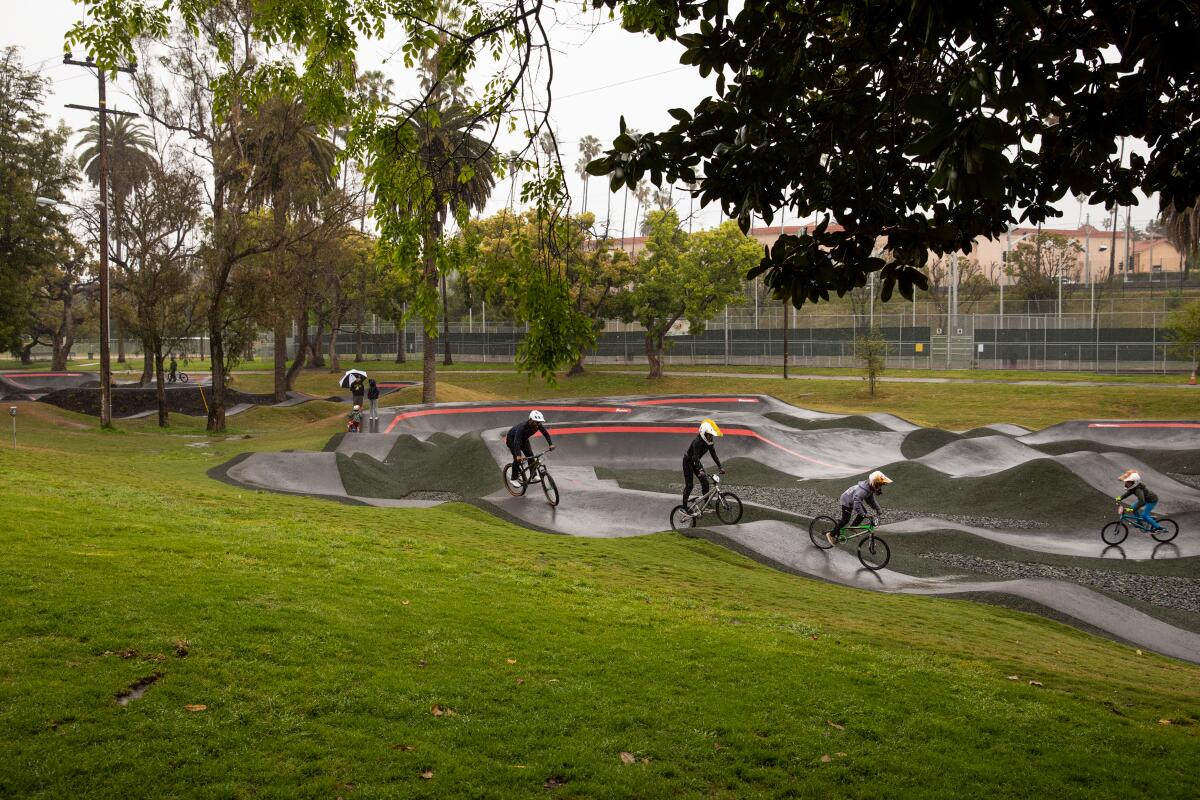
BMX athletes ride along the Inglewood track, which opened in September.
(Alisha Jucevic / For The Times)
The idea to build a pump track in Inglewood came to Eliot Jackson, a top 10 downhill mountain bike racer and top performer in the World Cup circuit, in 2020, when he started reflecting on his childhood.
Growing up in Oklahoma, Jackson and his older brother would build dirt jumps in their backyard. When the family moved to L.A., there was no place to ride that was away from vehicles, so Jackson’s mother would drive the boys to a biking track about 45 minutes away.
“A bike lane is not a safe place for kids and a lot of times sidewalks aren’t [either],” says Jackson, 33. “So I think for us, a pump track represents that first step to permanent cycling infrastructure — a place where I can say, ‘This isn’t going anywhere. … I have a place where I can go every single day, there’s community there, it’s safe [and] my parents are OK with me going there.’”
Visitors can also take Metro trains to get to the track, as it’s walking distance from the Downtown Inglewood and Fairview Heights stations.
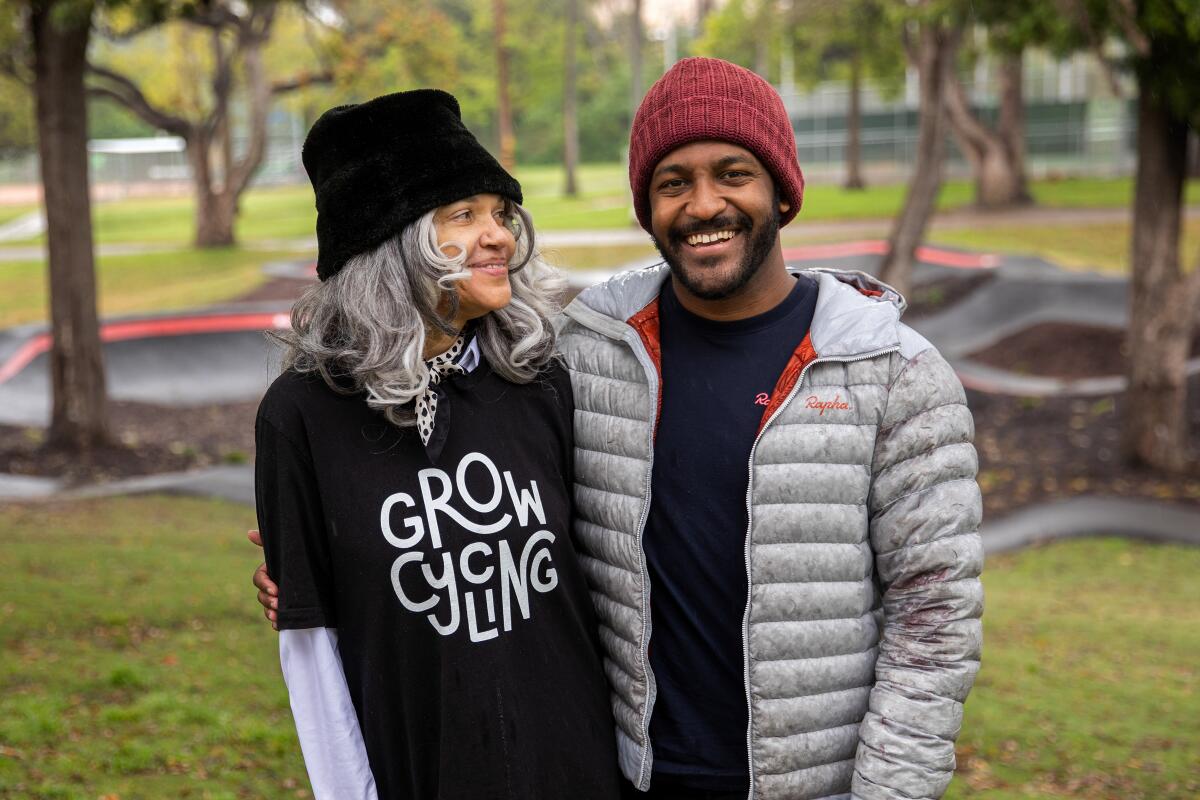
Eliot Jackson with his mother, Joi Jackson, Grow Cycling’s current president.
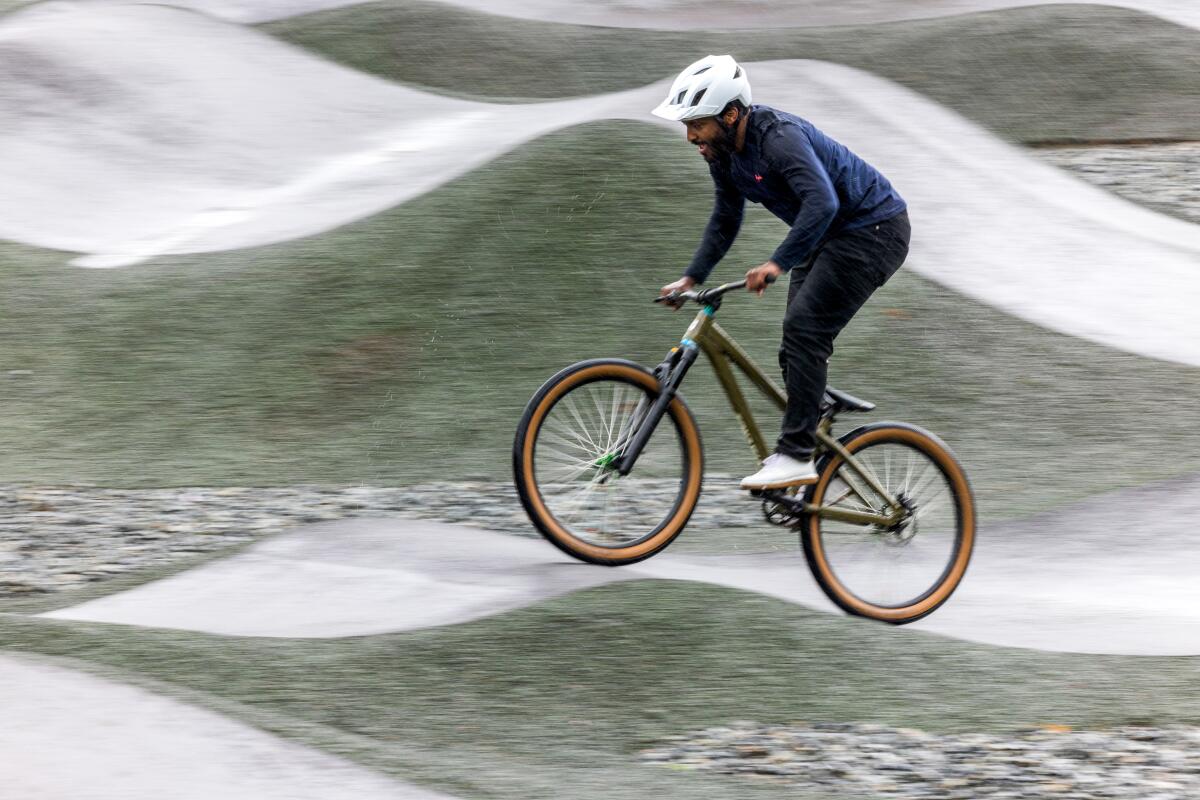
Eliot Jackson, a pro mountain biker, showcases his skills at the Inglewood Pumptrack.
(Alisha Jucevic / For The Times)
Jackson also hoped to help remedy the lack of diversity within the professional biking industry by building the track. Throughout his decade-plus long career, he was often the only Black person — or person of color — at the starting line at competitions. In August, after he retired from World Cup competition, Jackson launched the Grow Cycling Foundation, which is dedicated to making cycling more inclusive.
“I just thought about my life and all of the serendipitous things that led up to that,” says Jackson. Like his family “happening to move to California, where there’s mountains [and] my friend happening to take me up to Whistler Mountain Bike Park and introduce me [to downhill].”
“You start to think about the lack of opportunities that exist there, and I said, ‘What can I do?’” adds Jackson, who’s the chief executive of Grow Cycling, as well as a mountain bike expert for Red Bull.
The Inglewood Pumptrack, which cost $1.2 million, was fully funded by the cycling community for the cycling community with more than $300,000 in donations from individuals. The rest came from founding partners, including such brands as Yeti Cycles, Ride Fox, Pinkbike, Santa Cruz Bicycles, the Rapha Foundation and Adidas, Jackson says. (Jackson is also an ambassador for Santa Cruz Bicycles, Rapha and Fox.)
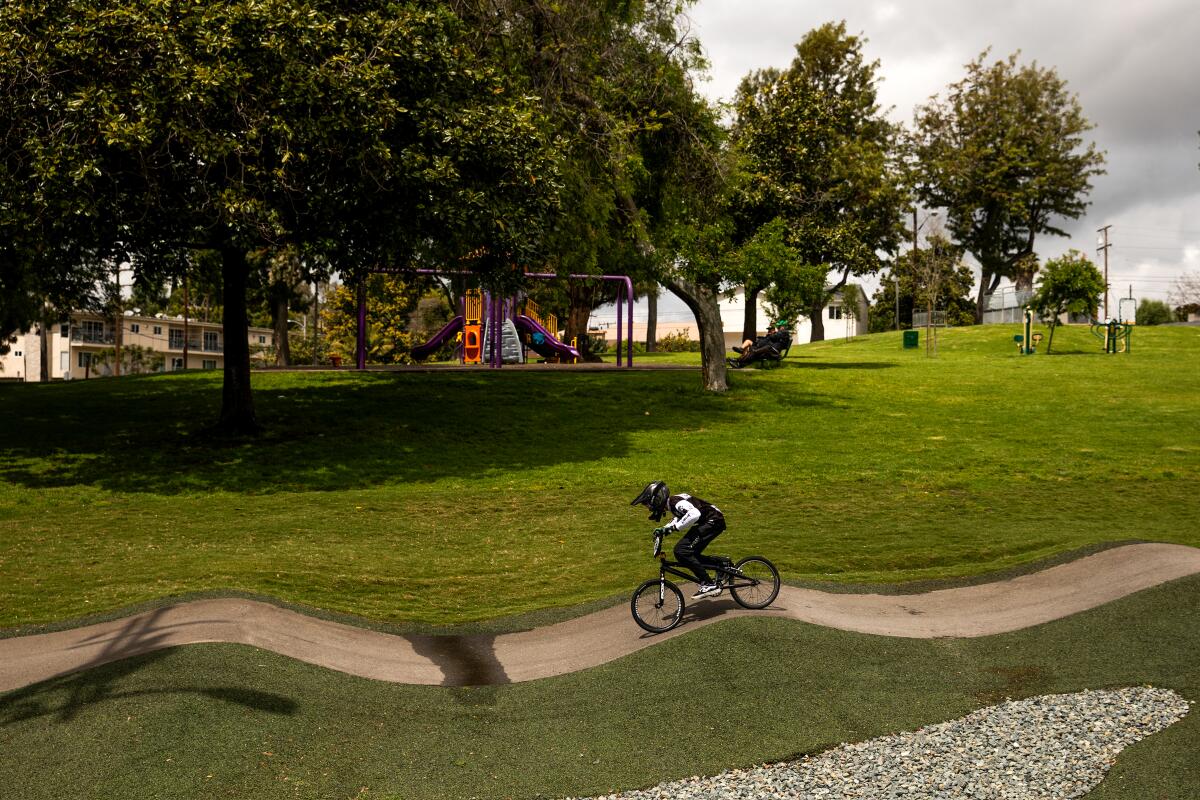
Jin Morita, 13, rides on the World Championship Track, one of two tracks at Inglewood Pumptrack at Edward Vincent Jr. Park in Inglewood.
(Alisha Jucevic / For The Times)
Constructed by Velosolutions, the site features two asphalt courses: The Woodlands and World Championship tracks. Woodlands, which is smaller and surrounds a host of trees, has smaller rollers and is designed for slower speeds. Whereas the colossus World Championship track, which is wider with large rollers, was built in a mirrored design so two riders can race in opposite directions at the same time. The design and name for this track was intentional as Jackson plans to host world championship competitions there. (Between both tracks, roughly 300 to 400 people were riding at the same time on opening day.) Both tracks are open to all ages and levels.
The Inglewood Pumptrack was specifically built with bicyclists in mind; for years, they were pushed out of skate parks and weren’t welcomed by the skateboarding community, says Joi Jackson, Eliot’s mom and the president of Grow Cycling.
They wanted to set a more inclusive precedent for bike infrastructure, so there are bike priority days at the track. Other wheels such as skateboards, longboards and rollerblades are welcome on specific days of the week. (A sign near the track entrance includes more details on this and other rules for the track.)
People who use wheelchairs or adaptive bikes can also utilize the track. However, no scooters or motorized vehicles such as e-bikes, hoverboards or electric scooters are allowed.
Ameri de Vera, 9, who rides BMX on a factory team for a company called Answer BMX, goes to the Inglewood Pumptrack at least twice a month with her older sister.
“I was scared at first because you have to get used to how it sways,” says De Vera, who was preparing for the BMX world championships on a recent Sunday. “It sways in different directions and there’s some sharp turns too. So you have to keep your eye on those, but it was really fun once I got used to it. And you can ride your skateboard on it.”
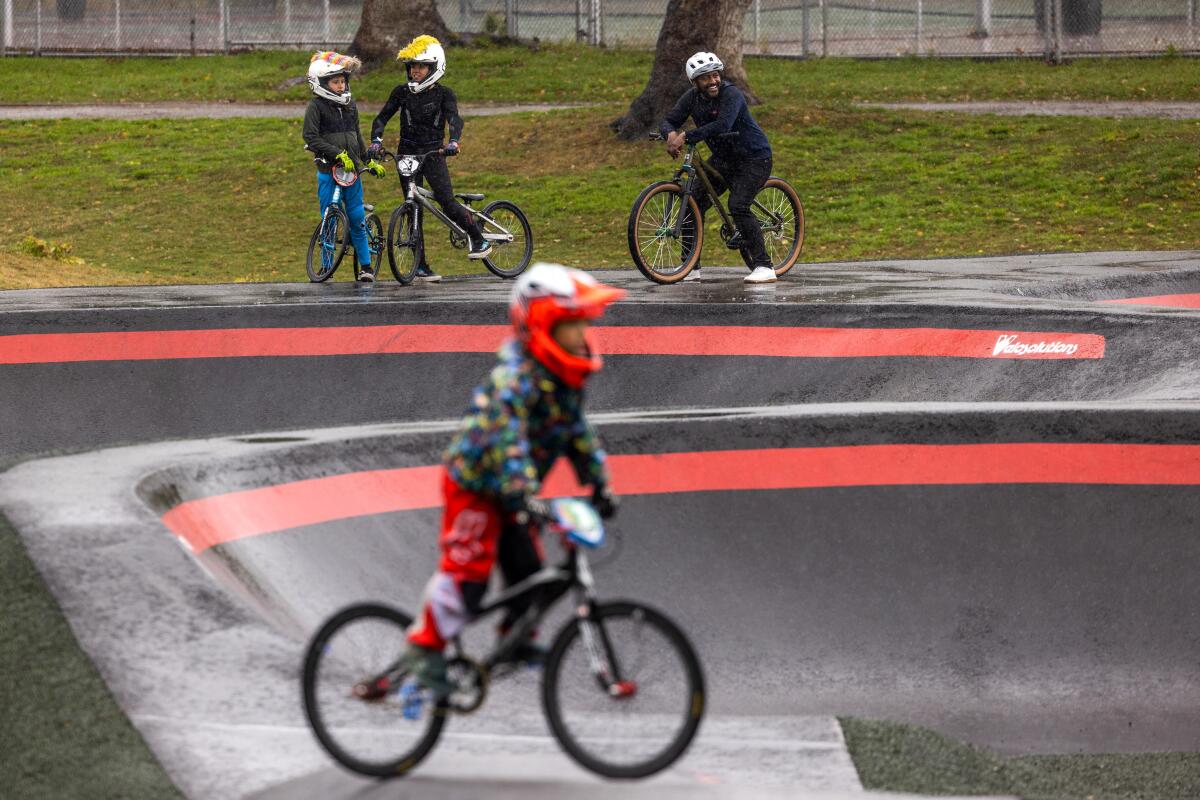
Eliot Jackson rides the Inglewood Pumptrack with BMX athletes, Ameri de Vera, 9, left, and her sister Vida de Vera, 11, center.
(Alisha Jucevic / For The Times)
For first-timers, she recommends gearing up and wearing a helmet for safety “because the first time, you’re probably going to fall.” She also encourages people to be aware of their surroundings and pay attention to what others are doing to avoid accidents.
Although there’s a skate ramp at the park, Erik Barnes, 50, says he prefers to ride on the pump track.
“There’s a proliferation of skate parks here, but none like this,” says Barnes of West Adams, who’s been an avid skateboarder since he was a teen. He sometimes brings his teenage son to the track with him.
“I meet a lot of guys my age or us older skaters who are just falling in love with this place. Everyone’s like, ‘It’s reignited skateboarding for me. It got me back into it,’ and that’s definitely the case for me.” Barnes frequents the track at least twice a week, usually before work.
What Barnes loves most about the track is that “you don’t have to be really good to enjoy this park.”
“You can kind of get yourself into a really fun zone of just cruising, which is a really pleasurable, fun thing to do,” he says. “It’s not exceedingly difficult.”
He adds, “You can just get into a nice flow. It’s rhythmic. It’s meditative and it’s a really good workout because you’re basically just doing squats the whole entire time.”
After not seeing many rollerskaters at the Inglewood Pumptrack each time they visited, Bily Ruiz, 26, started a weekly meetup called K.h.a.o.t.i.c Quads. The group, whose members range in age from 1 to 50, meet there on Sunday mornings.
“I love the community that [the track] is creating, because at some parks, the culture can be very standoffish or they don’t really talk to each other,” says Ruiz. Whereas at the Inglewood Pumptrack, “since everyone’s so excited, everyone’s like ‘What’s up? Hi. I see you. Good job.’”
“I look forward to it every weekend,” Ruiz says about about the group. “It’s so exciting, and every time we meet up, it fills me up with so much energy.”
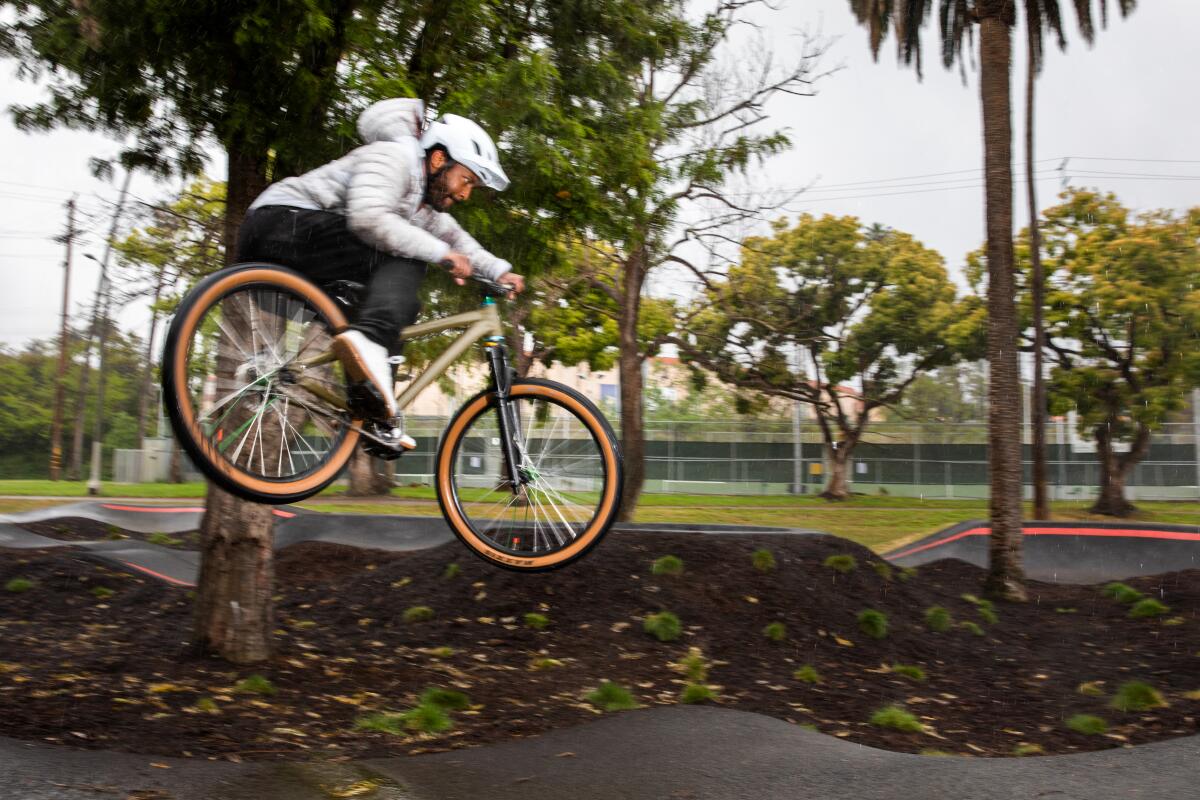
“We built something that people love and that makes me the most happy,” says Eliot Jackson.
(Alisha Jucevic / For The Times)
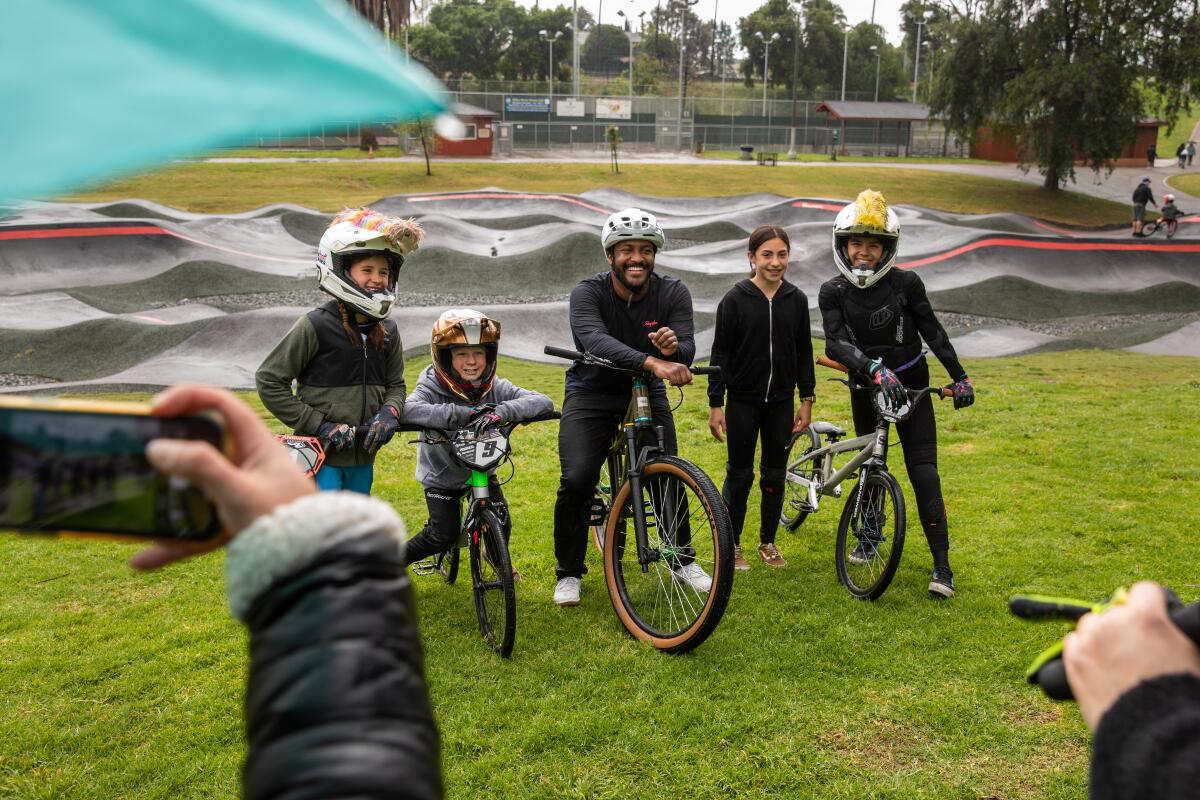
The parents of young BMX athletes take a photo of them with Eliot Jackson, center, at the Inglewood Pumptrack.
(Alisha Jucevic / For The Times)
The Grow Cycling Foundation has also donated permanent bike fleets to nearby in Inglewood elementary and middle schools , which they use for education programs. The organization views the pump track as the first step in a long-term mission to make cycling culturally relevant in the city.
In the meantime, though, Jackson says he’s enjoyed seeing kids who may have never seen or heard of a pump track before get to experience one for the first time — or simply fall back in love with riding bikes.
“We built something that people love and that makes me the most happy,” he says. “I just think about us as a family when we were growing up and my mom would’ve taken us every single day, and look at where I am now?
“And that will happen. There will be a kid who goes on to be better than I ever could because they got to discover a bicycle at this place.”
[ad_2]
Source link